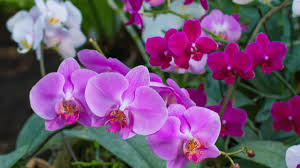# Recognizing When to Repot White Egg Orchids: A Comprehensive Guide

## Introduction
White Egg Orchids, scientifically known as **Dendrobium**, are beloved for their stunning beauty and delicate fragrance. However, maintaining these orchids requires careful attention, particularly regarding their potting needs. Repotting is an essential aspect of orchid care that significantly influences their growth and flowering. This article will explore the signs that indicate your White Egg Orchids need repotting and provide comprehensive guidelines on how to do it effectively.
## 1. Understanding White Egg Orchids
### 1.1 Characteristics of White Egg Orchids
White Egg Orchids are characterized by their slender stems and clusters of beautiful white flowers. They thrive in warm, humid environments and require specific care to flourish. Understanding their growth patterns is crucial for determining when to repot.
### 1.2 Importance of Repotting
Repotting is vital for several reasons:
– **Root Health**: Over time, potting media breaks down, becoming compacted and less aerated. This can hinder root growth and lead to rot.
– **Nutrient Availability**: Fresh potting mix provides essential nutrients that older media may lack.
– **Space for Growth**: As orchids grow, they may outgrow their pots, necessitating a larger space for root expansion.
## 2. Signs That Your White Egg Orchids Need Repotting
### 2.1 Root Growth and Health
1. **Visible Roots**: If you notice roots growing out of the drainage holes, it’s a strong indication that your orchid has become root-bound and needs a larger pot.
2. **Crowded Roots**: When you gently remove the orchid from its pot, check for tightly packed roots. If they are circling around the pot, it’s time to repot.
3. **Black or Mushy Roots**: Healthy roots should be firm and greenish-white. If you see any black, brown, or mushy roots, it’s crucial to repot and trim away the dead sections.
### 2.2 Potting Media Condition
1. **Decomposed Media**: Over time, potting media breaks down and can become compacted. If the media appears crumbly, discolored, or has a foul odor, it’s a sign that it needs replacing.
2. **Excessive Salt Build-up**: White crust on the surface of the potting media indicates salt build-up from fertilizers. This can harm the roots and necessitate repotting to refresh the media.
3. **Water Retention Issues**: If the potting media retains too much water and drains poorly, it can lead to root rot. This is often a sign that the media needs to be changed.
### 2.3 Plant Size and Growth
1. **Outgrown Pot**: If your orchid appears top-heavy or the leaves are crowded, it might be time to repot into a larger container.
2. **Stunted Growth**: A healthy orchid should show signs of growth and flowering. If your White Egg Orchid is not producing new leaves or flowers, it could be a result of being root-bound or needing fresh media.
3. **Flowering Issues**: If your orchid fails to bloom or produces fewer flowers than in previous years, it might indicate that it’s outgrown its pot and requires repotting.
### 2.4 Time of Year
1. **Optimal Repotting Season**: The best time to repot White Egg Orchids is during their active growing season, typically in spring or early summer. This allows the plant to recover quickly and encourages new growth.
2. **Post-Bloom Repotting**: Consider repotting right after the flowering period, as this is when the plant is not putting energy into blooming and can focus on recovering from the repotting process.
## 3. How to Repot White Egg Orchids
Repotting your White Egg Orchids may seem daunting, but following these steps will make the process easier and more effective.
### 3.1 Gather Necessary Supplies
Before you begin, make sure you have the following materials:
– Fresh orchid potting mix (specifically designed for orchids)
– A new pot (choose a pot that is one size larger than the current one)
– Sterilized scissors or shears
– A small wooden stick or tool to help with positioning
– A potting surface (newspaper or plastic sheet for easy cleanup)
### 3.2 Preparing for Repotting
1. **Watering**: Water your orchid a day before repotting to make the roots easier to handle. This helps hydrate the plant and reduces stress during the process.
2. **Choose a Suitable Location**: Find a clean, well-lit area to perform the repotting. Ensure good ventilation to avoid any stress on the orchid during the transition.
### 3.3 Removing the Orchid from Its Pot
1. **Gently Remove the Orchid**: Carefully slide the orchid out of its pot. If it’s stuck, you can gently squeeze the sides of the pot or use a small tool to help release it.
2. **Inspect the Roots**: Once out, examine the roots closely. Trim away any dead or unhealthy roots using sterilized scissors. Healthy roots should be firm and white to green in color.
### 3.4 Potting the Orchid
1. **Prepare the New Pot**: Place a layer of fresh potting mix at the bottom of the new pot. This provides a base for the roots.
2. **Position the Orchid**: Place the orchid in the center of the pot, ensuring that the crown of the plant (where the leaves meet the roots) is slightly above the potting mix.
3. **Fill with Potting Mix**: Gradually add more potting mix around the roots, using a stick or your fingers to gently pack it down. Ensure there are no air pockets, as these can lead to root issues.
4. **Water Thoroughly**: After repotting, water the orchid thoroughly to help settle the media around the roots. Allow the excess water to drain out.
### 3.5 Post-Repotting Care
1. **Avoid Direct Sunlight**: For the first few weeks after repotting, keep the orchid out of direct sunlight to reduce stress.
2. **Maintain Humidity**: Ensure the environment remains humid, as this will help the orchid recover from the repotting process.
3. **Monitor Growth**: Keep an eye on your orchid for signs of recovery. Look for new growth, which indicates that the plant is adjusting well to its new environment.
## 4. Best Practices for Orchid Potting
To ensure the health and longevity of your White Egg Orchids, here are some best practices for potting:
### 4.1 Choosing the Right Potting Media
1. **Specialized Orchid Mix**: Always use a potting mix specifically formulated for orchids. This mix usually contains bark, perlite, and other materials that provide excellent drainage and aeration.
2. **Avoid Soil**: Traditional garden soil retains too much moisture and can lead to root rot. Opt for orchid-specific mixes for best results.
### 4.2 Selecting the Right Pot
1. **Size Matters**: Choose a pot that is one size larger than the current pot. An oversized pot can lead to water retention and root problems.
2. **Drainage Holes**: Ensure the pot has adequate drainage holes to prevent water accumulation, which can cause root rot.
3. **Material Consideration**: Consider using terracotta pots for better breathability, or plastic pots for lightweight options that retain moisture well.
### 4.3 Timing is Key
1. **Seasonal Awareness**: Remember that spring and early summer are ideal times for repotting. This aligns with the orchid’s natural growth cycle.
2. **Monitor Flowering**: Avoid repotting during the blooming phase, as this can stress the plant and affect its ability to flower.
## 5. Common Mistakes to Avoid When Repotting
1. **Ignoring Root Health**: Always inspect the roots before repotting. Neglecting to trim dead roots can hinder the plant’s recovery and growth.
2. **Overpotting**: Choosing a pot that is too large can lead to excessive moisture retention and root issues. Stick to one size larger.
3. **Skipping Watering After Repotting**: Failing to water the orchid after repotting can lead to dry conditions for the roots. Always water thoroughly after the process.
4. **Repotting Too Frequently**: While regular repotting is essential, overdoing it can stress the plant. Aim to repot every 1-2 years or when necessary.
5. **Neglecting Environmental Needs**: After repotting, provide appropriate light, humidity, and temperature to help your orchid recover and thrive.
## 6. Conclusion
Recognizing when your White Egg Orchids need repotting is crucial for their health and longevity. By understanding the signs and following proper repotting techniques, you can ensure your orchids remain vibrant and flourishing. With careful attention to their needs and a commitment to proper care, your White Egg Orchids will reward you with beautiful blooms for years to come.
By maintaining a regular check on their root health, potting media condition, and overall growth, you can foster an environment where your White Egg Orchids can thrive. Remember to enjoy the journey of caring for these exquisite plants, as each bloom is a testament to your efforts and dedication.
—

